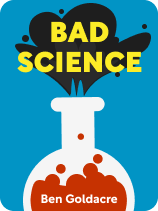

This article is an excerpt from the Shortform book guide to "Bad Science" by Ben Goldacre. Shortform has the world's best summaries and analyses of books you should be reading.
Like this article? Sign up for a free trial here.
What is the harm of misleading science articles? What is the impact of journalism on the scientific community?
Journalism is essential for sharing important information about the latest in science. However, as Ben Goldacre claims in Bad Science, journalism has the potential to spread misinformation that has a lasting impact on the public.
Below, we’ll look at the many ways mainstream media outlets could misrepresent scientific findings.
Bad Press
According to Goldacre, errors in science reporting usually happen because publications prioritize profit, which leads them to pressure their reporters to generate the most exciting stories they can as quickly as possible. This pressure leads reporters to choose sensational stories, and leaves them little time to verify the accuracy of their reporting. This then leads to misleading science articles being published.
(Shortform note: As opposed to the profit motive, journalists argue that one of the main reasons for their errors is that they often have to report on evolving events. Journalists describe trying to balance getting information out quickly with taking enough time to gain a complete understanding of a topic. Naturally, they argue, this process involves some mistakes.)
Goldacre argues that it’s important for publications to accurately report medical findings because of their unique role in spreading ideas. Misinformation can undermine public health campaigns and lead individuals to make dangerous healthcare decisions.
(Shortform note: Many journalists would agree that they have an ethical responsibility to report accurately, especially when writing about medical issues. Interestingly, journalistic codes of ethics often include the imperative to minimize harm—a sentiment echoed by the Hippocratic Oath, which is the cornerstone of medical ethics.)
There are a few major ways journalists tend to misrepresent scientific studies. Specifically, publications fail to evaluate their sources, sensationalize results, and fail to correct their mistakes by publishing retractions and updates. We’ll describe how all these practices can be used to mislead the public, and we’ll give you the tools to identify shoddy science reporting.
Bad Sources, Bad Stories
According to Goldacre, journalists often fail to properly vet the scientific sources they reference. When journalists use untrustworthy sources, they risk presenting misleading and potentially harmful information to the general public.
Goldacre argues that one of the main reasons journalists end up using weak sources is because most journalists aren’t scientists, and they lack the training to evaluate medical research. Even though mainstream publications often employ a few science reporters with more specific expertise, major stories tend to be assigned to higher-ranking general journalists instead.
(Shortform note: One reason general journalists may have a hard time reporting on science is that scientific results are often uncertain. As compared to current events, where there is a clear chain of events to report, scientific findings often suggest more tentative links. General journalists who are unfamiliar with these nuances tend to overstate inconclusive findings.)
However, Goldacre asserts that regular people can learn to evaluate scientific sources with a little work. The issue isn’t that journalists aren’t capable of understanding science, but that low industry standards and the pressure of deadlines disincentivize journalists from doing so.
(Shortform note: Journalists themselves corroborate Goldacre’s assertion that high-pressure environments in journalism are a systemic problem. Studies show that the vast majority of journalists experience trauma and burnout on the job. Without reforms in journalism, these stressful environments may continue to lead to mistakes in reporting.)
Spotting Bad Sources
When you read science stories in mainstream media outlets, you should investigate their sources. Once you’ve found the studies an article references, you can evaluate them yourself using the techniques we’ve developed in this guide. And, as Goldacre sees it, if an article doesn’t link to its sources, it probably isn’t trustworthy.
It can also be helpful to research the authors of the articles you read. Look into the author’s background and other work. If they have a science background and focus primarily on science reporting, it’s more likely that they have the right tools for the job. On the other hand, if the author of an article has no science background and reports mostly on other topics, it may be a sign that you should investigate their claims more thoroughly.
(Shortform note: In addition to looking into the backgrounds of science journalists you come across, you can also seek out trustworthy scientists on your own. Since the advent of social media, many scientists have taken to the internet to share their findings. Taking it on yourself to identify and follow reliable sources can help ensure you have access to accurate information.)
Sensational Stories
Furthermore, journalists misrepresent scientific information to the general public by sensationalizing clinical findings. Goldacre notes that this isn’t unique to science journalism, but is a more general problem with journalism. To maximize readership and revenue, publications often encourage their reporters to write shocking, provocative stories, even if it means exaggerating. However, because science journalism impacts public health, sensational science reporting can cause significant harm.
As Goldacre describes it, journalists tend to focus on scary findings because they’re seen as better attention grabbers. For instance, stories about common household chemicals causing cancer are more likely to attract readers than stories about incremental advancements in treating lactose intolerance. It isn’t inherently misleading to publish frightening stories, as long as those stories are accurate, but sadly this isn’t always the case.
Rare Retractions
Finally, Goldacre laments that when journalists publish findings that are later proven to be false, they rarely publish retractions that include new evidence. Because of the potential impact of journalism on public health, Goldacre argues that media outlets have an ethical obligation to provide accurate, up-to-date information.
(Shortform note: Some studies have found that journalists only publish retractions when researchers make a press release detailing how their findings have changed. These studies suggest that when retractions are necessary, researchers may be able to help the process along by reaching out to journalists directly and making press releases.)
The panic over the MMR vaccine is a perfect example of the real-world consequences that can occur when journalists don’t take it upon themselves to publish retractions. As Goldacre recounts, in the early 2000s, British journalists published numerous articles about the supposed link between the MMR (measles, mumps, and rubella) vaccine and autism. These stories were based on the results of a single study, which used poor experimental controls and relied on surrogate outcomes. While the study in question was later discredited due to its shoddy methods, few publications published retractions. As a result of the ensuing panic over the MMR vaccine, vaccination rates in the UK plummeted, leading to waves of preventable illness and death.
(Shortform note: Even when publications do publish retractions, it often happens years after the damage has been done. One publication involved in the British MMR scare launched an admirable campaign to promote the MMR vaccine. This 2019 campaign likely saved lives by encouraging vaccination, and had it been published sooner, it could have saved many more.)
Accounting for Missing Retractions
When you read an article, you should check to see when it was published, and even more importantly, you should check to see when the studies it references were published. Scientific research is an ongoing process, and results from just a few months ago may have already been overturned. Because of this, you should try to find the most recently published research into any particular subject. That way, you can be sure you’re up to date on the most effective treatments.
(Shortform note: While it may seem daunting to continually keep up to date on new findings, openness to new evidence is part of what makes the scientific method reliable. To account for constant change, remember that science is an ongoing process, and be ready to change your opinion when necessary.)

———End of Preview———
Like what you just read? Read the rest of the world's best book summary and analysis of Ben Goldacre's "Bad Science" at Shortform.
Here's what you'll find in our full Bad Science summary:
- The strategies researchers, corporations, and journalists use to mislead the public
- The tools you need to identify and call out shady science when you see it
- Why media outlets have an ethical obligation to publish retractions






